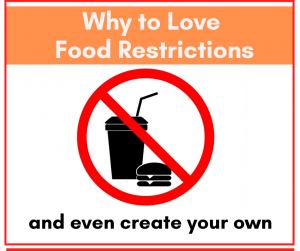
A running shoe company (Adidas, I think) used to have a “No Bounds” marketing campaign. The idea was to encourage runners to break through barriers and boundaries–not only physical but mental, too.
It was a great idea for running–and many other pursuits, too. But not for eating. When it comes to eating, boundaries can be best friends.
I remember when I had to adopt a gluten-free, dairy-free diet. Prior to that time, I had “No Bounds” when it came to bread, cheese, and everything else gluten and dairy. I would happily eat 5 pieces of toast for breakfast, a grilled cheese for lunch and pizza for dinner. Rounding out my diet were Raisin Bran with milk, quesadillas, cheesy pasta dishes and an occasional salad–covered with cheese. When donuts, muffins and pastries were available in the office kitchen, I always ate them in multiples and I couldn’t help myself around homemade cake.
Having to eliminate gluten and dairy saved me from myself. Finally, I had some boundaries–and it was unexpectedly comforting.
Natural Boundaries We know we need to set boundaries with our kids, our emotions and our time. Yet how many of us set health-saving boundaries around food?
There was a time (several millennia, in fact) when we were kept in check by natural boundaries. Food was so scarce and/or expensive that it would have been practically impossible to overeat day after day.
But then came the industrialization of food and agriculture, which accelerated rapidly in the 50s and 60s. Suddenly, we were able to grow massive amounts of food and process them into cheap, readily available and easily edible forms.
Without any natural boundaries all hell broke loose. It was like letting the boarding school girls loose on the town for a night!
Addictiveness Making matter far worse, the foods unleashed on us were not just substitutes for the foods we might make at home, but are an entirely new breed—created and manufactured specifically to be addictive and eaten in quantities that are highly profitable to their manufacturers.
Artificial Boundaries to the Rescue Hence the need to create our own, artificial boundaries since our natural eating boundaries have been blown out of the water.
Having a gluten- and dairy-free boundary imposed on me was a blessing. True, it eliminated 75% of my diet, which was inconvenient and discombobulating. But it was the 75% that I had completely OD’d on and that was had me careening down a path of disaster. Only a hard boundary could rein me in.
The Science My experience with boundaries was confirmed a couple years ago when I first heard a talk by Susan Pierce Thompson, a psychology professor with a Ph.D. in Brain and Cognitive Sciences. Through her research, she discovered that “bright lines” (her version of artificial boundaries) work so well because they free us from the need to constantly rely on willpower to make healthy food choices. As she explains:
Willpower is like a rechargeable battery that drains very quickly. In our modern-day environment [where we are constantly and continually bombarded with unhealthful choices], it’s an entirely unreliable source of power for consistently making healthy food choices.
Instead of having to rely on willpower, a dubious approach to begin with, artificial boundaries give you an easy path to follow that requires no nail-biting, excruciating, anxiety-provoking decisions. Instead good choices become automatic, requiring no thought.
Jealous? All of a sudden, you may be feeling jealous of those with helpful food restrictions! No worries, you can set your own–which is what Bright Lines are. They are artificial boundaries that you commit to, unequivocally. There are a total of four official Bright Lines, but only two are relevant to this discussion: eliminate 1) flour and 2) sugar.
Doesn’t sound like much, right? But realize that of foods that don’t serve your health, almost every one contains one or both of those two. So in one fell swoop, you’re putting the bulk of problem foods out of bounds.
Don’t worry about them anymore. Don’t toy with the idea that maybe you could have a little, just this once. No, you’re done, now and forever. In your world, those foods aren’t foods to you. Over and out.
But Protect Those With Real Food Restrictions It’s important to protect those who have real food restrictions, however. In other words, when eating out, whether in restaurants or at other people’s houses, please be careful not to make a deal about whether a dish includes flour, sugar or whatever—and then eat a piece of the warm French bread that just came out of the oven or a bite of the irresistable chocolate cake! That makes others skeptical and not as willing to help those with true health issues.
Remember, commit, unequivocally.
For the most part, it’s pretty clear what foods have flour or sugar—just avoid them. Fortunately, if you don’t actually have allergies or sensitivities and get a little gluten or dairy or sugar, it won’t be harmful as it would be for a person with celiac, and you’ll learn how to be more discerning in the future.
To boundaries!